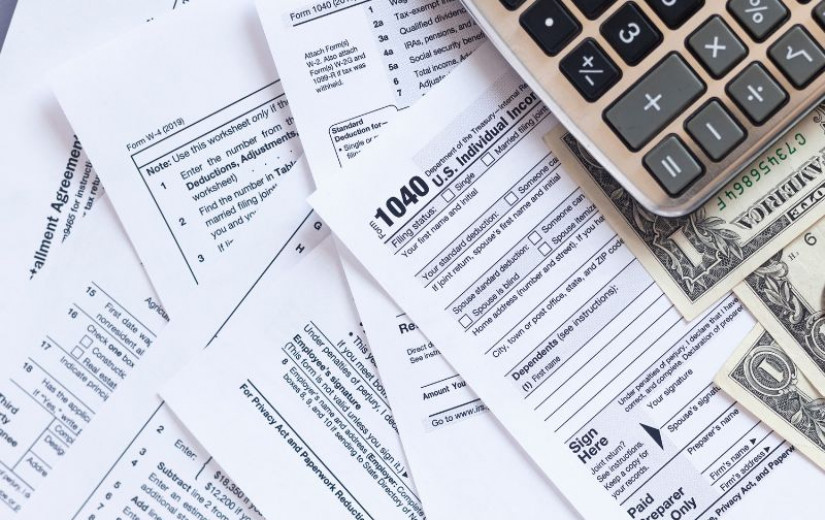
WASHINGTON, DC - APRIL 07: U.S. President Donald Trump answers a reporters question during a meeting with Israeli Prime Minister Benjamin in the Oval Office of the White House on April 7, 2025 in Washington, DC. President Trump is meeting with Netanyahu to discuss ongoing efforts to release Israeli hostages from Gaza and newly imposed U.S. tariffs. (Photo by Kevin Dietsch/Getty Images)
Getty ImagesAboard Air Force One on Sunday, President Trump rationalized the effect his chaotic tariff talk was having on global stockmarkets. “I don't want anything to go down, but sometimes you have to take medicine to fix something,” he said.
Oil companies have already had enough medicine. Crude oil closed down 1.65% at $61 a barrel today, after briefly dipping below $60. That's off more than $10 in a week and 25% lower than when Trump took office. Investors fear that Trump’s tariffs will cause recession and flatten oil demand. Meanwhile there are signs of a global glut, as OPEC announced Friday it would be pushing 411,000 barrels per day back onto the market sooner than expected. The Saudis then lowered their prices. Good for motorists, the average gallon of gasoline is now $3.26. But bad for oil companies, ETFs like XLE, XOP and OIH have sold off 20% in the past week.
Is it time to buy discounted American oil? Depends on where you believe the ultimate pain point is. Analysts at TPH & Co. quipped today that below $60/bbl companies alter their plans, while at $50 almost all will go back to the drawing board. The consultancy Rystad said that when you factor in dividends and debt service costs nearly all oilfields in the U.S. require an oilprice north of $62 to “breakeven.” A response published in the quarterly oil industry survey by the Dallas branch of the Federal Reserve summed it up well: “Drill, baby, drill” does not work with $50 per barrel oil. Rigs will get dropped, employment in the oil industry will decrease, and U.S. oil production will decline as it did during COVID-19.
It’s unlikely that Trump’s tariffs will grind the gears of capitalism to a halt the same way pandemic lockdowns did. A better bet: that oil prices won't spend much time below $60/bbl. That’s thanks in part to the industry-wide PTSD from 2020 (as well as 2016’s OPEC Shale Slamdown) which transformed once-aggressive young frackers into prudent capital allocators. No one is still drilling uneconomic wells just to hold onto leases.
As a result the balance sheets of independent American oil companies are stronger than they've been in a generation, and valuations embarrassingly low. A preferred valuation metric these days is EV/Ebitda, or enterprise value (equity plus debt) divided by Ebitda (operating income). By this measure nearly all American oil companies look cheap, with Occidental Petroleum coming in on the high side at 5.1x EV/Ebitda. Occidental might be worth the premium because of an implied put from "Uncle Warren" — Berkshire Hathaway owns 34% of Oxy shares and at a current $38.75 could buy the rest for about $25 billion (and still have $300 billion of cash on hand).
But you can buy cheaper oil companies. According to 2025 forecasts from Michael Scialla at Stephens (with data as of last Friday's close), Permian pure-play Diamondback Energy sells at EV/Ebitda of 3.8x. Even better is unloved Ovintiv at 3.3x and a 3.6% yield. Smaller player Crescent Energy has been growing by acquiring private-equity-backed E&Ps and trades at just 2.3x EV/Ebitda — that’s like paying off the whole company with less than three years of cashflow.
All of these stocks have been decimated in the past week to April 7, with Oxy down 21%, FANG off 22%, OVV -24%, and CRGY -30%. Buy at a discount and chill, baby chill.
Looking at the oilfield service companies, which are often first to see contracts dry up and orders canceled, analyst Marc Bianchi at TD Cowen wrote this morning that “prior company messaging has become irrelevant and we expect any guidance to be abandoned waiting for more clarity.” He sees a deep slowdown, with possible recovery not until 2027. Favorite defensive plays include companies with backlog-driven businesses that are insulated from the short-cycle shale drilling world. TechnipFMC (FTI) for example, is building giant oil installations offshore Norway for Equinor that will tie them up for years; it trades at 6 times EV/Ebitda with no net debt but down 24% in the past week. Meanwhile Baker Hughes (8x EV/Ebitda, down 19% in past week), which builds large energy equipment, returned $1.3 billion to shareholders last year through buybacks and dividends.
Analyst James Carreker at U.S. Capital Advisors likes midstream company Targa Resources (down 18%), which has indicated that it can keep growing its pipeline volumes around the Permian basin for 10 years even with $50 oil.
For an even safer energy option, there's electric utilities, generally insulated from the tariffs mess. Duke Energy sports a 3.5% dividend yield and analyst Anthony Crowdell at Jefferies sees it growing earnings at nearly 7% over the next few years. Also Xcel Energy, with 8% EPS growth and 3.4% yield, is in the interesting position of owning a coal-fired power plant that was scheduled to be mothballed but that now, under Trump 2.0, who knows?
Given a deep enough oil washout, Trump can always order the Department of Energy to backstop domestic oil demand with a plan to refill the 180 million barrels that Joe Biden drained and sold from the Strategic Petroleum Reserve at prices around $90 per barrel. A deal to buy 1 million barrels per day of deeply discounted 100% American Oil would help lift animal spirits.
ForbesLights Out For Sunnova? Bankruptcy Looms After CEO Berger’s ExitBy Christopher Helman
ForbesThe Trillion-Dollar A.I. Data Center Tsunami —Coming To A Field Near YouBy Christopher HelmanForbesThis Former Billionaire, And New U.S. Senator, Is Now BrokeBy Christopher HelmanForbesThe Texas Tycoon Making A New Fortune Selling Sand To FrackersBy Christopher Helman








